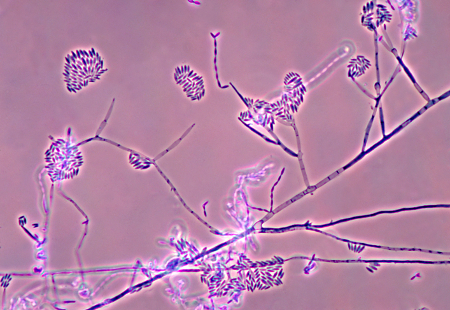Aetiology
T-2 mycotoxin is a group A trichothecene mycotoxin, mostly produced by Fusarium species of fungi.
Trichothecene mycotoxin exposures are largely caused by ingestion of contaminated food, mostly grains. Exposure through consumption of meat, eggs, or dairy from animals fed contaminated grain is also possible.[5] Other routes of exposure include inhalation or skin contact.[10] Human-to-human transmission may occur via skin contact; therefore, decontamination of possibly affected patients is paramount.
T-2 mycotoxin is a potent toxin. The lethal dose 50 (LD50) is 1.6 to 3.8 mg/kg (mouse, intravenous injection) and 0.24 to 0.94 mg/kg (mouse, inhalation). The blistering seen is similar to that with sulfur mustard, but occurs at 1/400th of the dose. The LD50 (mouse, intravenous injection) for diacetoxyscirpenol (DAS) is 12 mg/kg.[11] DAS was used as an experimental chemotherapeutic agent in phase 1 and 2 trials in the 1970s.[12]
Co-contamination of multiple mycotoxins in food is common, which can result in complex mixture effects.[5] Chemical or biological transformation of ‘parent’ mycotoxins can also occur, altering the bioavailability, toxicology, and analysis of the toxins; these mycotoxin derivatives have been collectively termed ‘modified mycotoxins’.[2][3]
[Figure caption and citation for the preceding image starts]: Fusarium species photomicrographCDC/Dr Libero Ajello; used with permission [Citation ends].
Pathophysiology
Trichothecenes are potent inhibitors of protein, RNA, and DNA synthesis, and interact with the cell membranes. T-2 mycotoxin inhibits protein synthesis by attacking ribosomal RNA at the 80S ribosome. This interrupts peptide linkages, and initiation and termination sequences are reduced, which disrupts the ribosomal cycle. Their toxicity is linked to the highly reactive epoxide 12,13-epoxy-trichothecene ring. Deoxynivalenol enters the cell and binds to ribosomes that transduce a signal to RNA-activated protein kinase and haematopoietic cell kinase. This results in phosphorylation of mitogen-activated protein kinases that drives transcription factor activation apoptosis.[13]
Diacetoxyscirpenol has a similar mechanism of action to the epoxide metabolite of T-2 toxin.[14]
Use of this content is subject to our disclaimer